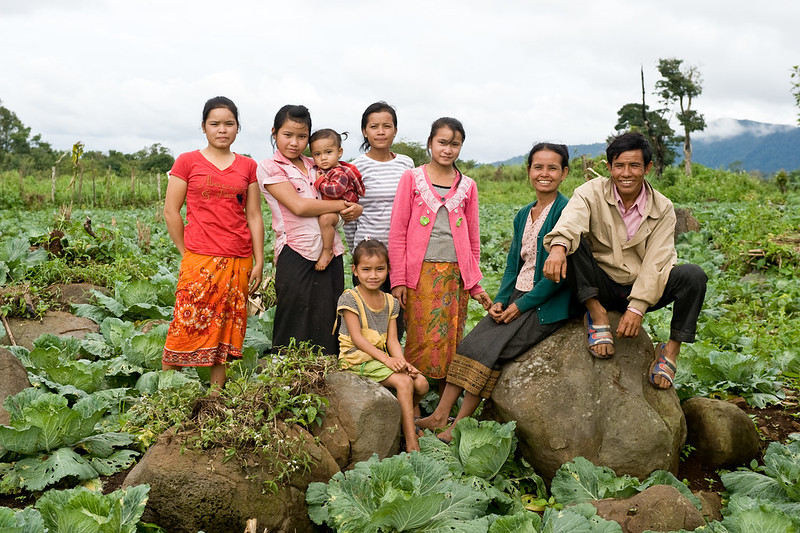Fighting Food Insecurity in Laos: Agriculture for Nutrition
 Pregnant with her third child in 2018, Ms. Sengphet, a farmer from the Long Peau village in Northern Laos, attended the Agriculture for Nutrition (AFN) program’s Farmer Nutrition School. Here, she learned about the essentials of nutrition for her children. Additionally, she heard of more opportunities from the $38.8 million initiative jointly undertaken by the World Food Program (WFP), the International Fund for Agricultural Development (IFAD) and the Lao Government.
Pregnant with her third child in 2018, Ms. Sengphet, a farmer from the Long Peau village in Northern Laos, attended the Agriculture for Nutrition (AFN) program’s Farmer Nutrition School. Here, she learned about the essentials of nutrition for her children. Additionally, she heard of more opportunities from the $38.8 million initiative jointly undertaken by the World Food Program (WFP), the International Fund for Agricultural Development (IFAD) and the Lao Government.
With a $120 “Garden Grant” from the AFN, Sengphet purchased 10 chickens, feed and seeds for an at-home garden. From the initial investment, she has expanded her farm’s capacities from chicken to garlic, fish and frogs. This expansion helped her to earn up to $420 monthly since 2021. With AFN, Sengphet has grown her farm to fight food insecurity in Laos, which is faced by one in seven population members.
Malnutrition and Food Insecurity in Laos
Despite falling poverty levels, food insecurity in Laos remains a significant concern, particularly in rural areas where food shortages are twice as high as in urban regions. Three-quarters of households produce subsistence food and two-thirds of farmers grow rice exclusively. The lack of diversity contributes to malnutrition in addition to food shortage.
Limited access to nutritious food has resulted in high stunting rates among children, with 32.8% of those younger than 5 years of age affected. In some of the more impoverished provinces, this rate rises to 54%. The Lao government has prioritized tackling malnutrition by enacting the National Nutrition Strategy for 2025 and the National Nutrition Action Plan for 2021-2025. However, addressing food insecurity remains challenging due to high inflation and strong debt pressure in the past two years.
How APN Is Targeting Food Insecurity
The AFN program implements targeted initiatives to ensure sustainable food access. In 2016, the WFP, IFAD and the government launched the first phase in 400 villages across four provinces in Northern Laos. The program takes a holistic, community-based approach, emphasizing long-term self-sufficiency and various aspects of production. AFN collaborates with villages to develop road infrastructure, irrigation and market access, both with enterprises and through local market facilitation.
A significant part of AFN’s programming is its training initiatives and grants. AFN helps form and funds Agricultural Production Groups to farm selected products such as fish, poultry and vegetables. Furthermore, the program provides training for production techniques and opportunities for learning exchange via its Farmer-to-Farmer Extension Activities. These services are in addition to the Farmer Nutrition School and Garden Grant from which Sengphet benefitted.
Program Success
The first phase, which ended in 2022, has successfully met its targets to reduce food insecurity in Laos. It has reached 210,684 people, representing 92.5% of its goal. Around 57% of the people reached were women. Furthermore, it has helped bring 17,850 households out of poverty out of its targeted 21,000, defined by an income per capita of $270.
AFN’s impacts compound over time. In Nam Lee village, residents participating in a Village Development Planning session expressed a need for better road access to farmland and more profitable crops. With an AFN grant, the villagers constructed a 4km road to support their farming activities. By January 2021, this road access had increased productivity, with families generating $36,000 annually.
Sengpeut also highlights what the added income has provided for her family: “With my additional income,” she says, “I have been able to pay for my children’s education and build a new house. I have learned how to give medicine and vaccines to my animals and I am now part of making decisions in my house with my husband.”
With the success of Phase I, the three cosponsors are launching Phase II of the program. This phase expands to three additional provinces, targeting an extra 168,000 people. As Laos grapples with macroeconomic challenges, the AFN continues to offer sustainable solutions and combat food insecurity across small and medium scales, reaching the nation’s most vulnerable communities.
Final Remark
With the success of Phase I, the three co-sponsors are rolling out Phase II of the program. They have added 3 more provinces to the program, targeting an additional 168,000 people. As Laos continues to face macroeconomic challenges, the AFN provides sustainable solutions and fights food insecurity in Laos across small and medium-scales to the nation’s most vulnerable communities.
– Imme Koolenbrander
Imme is based in Beijing, China and focuses on Business and New Markets for The Borgen Project.
Photo: Flickr
